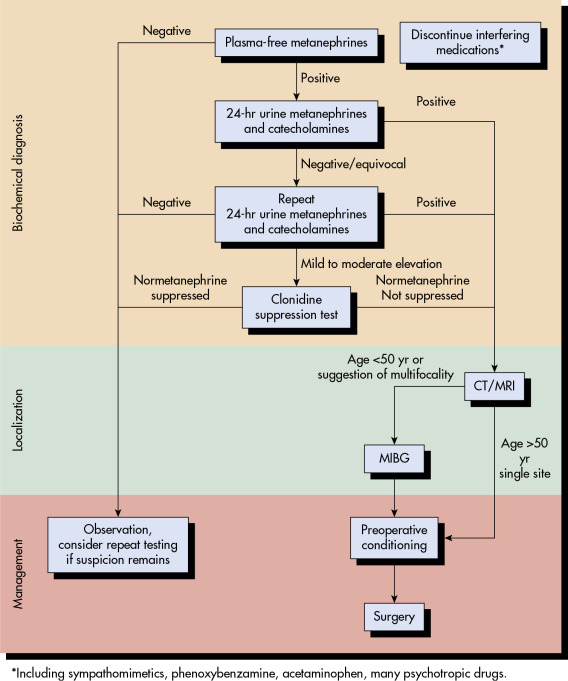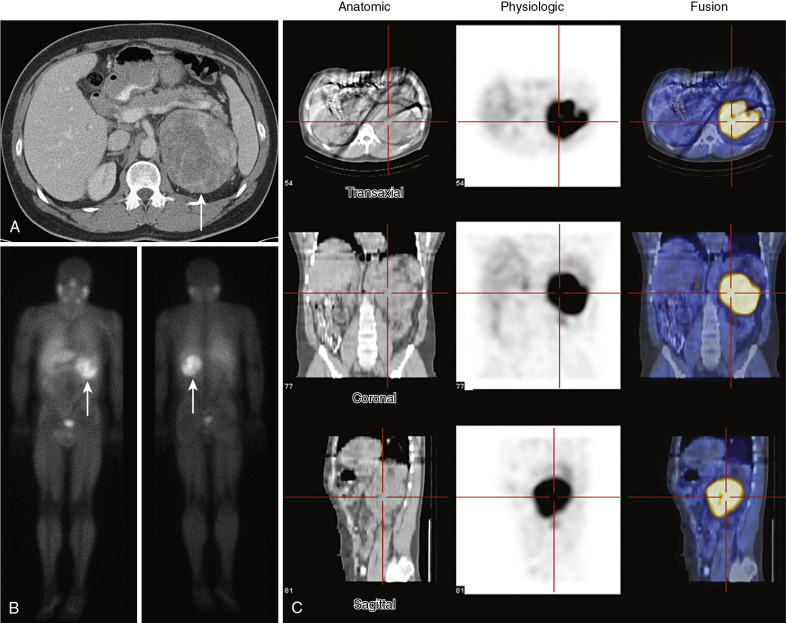Author: Brett Patrick, MD and Mark F. Brady, MD, MPH, MMSc, and Fred F. Ferri, MD
Pheochromocytomas are catecholamine-producing tumors that originate from the chromaffin cells of the adrenergic system. While they generally secrete both norepinephrine and epinephrine, norepinephrine is usually the predominant amine.
| ||||||||||||||||
- Incidence: 0.05% of population; peak incidence in 30s and 40s.
- Approximately 25% of patients with apparently sporadic pheochromocytoma may be carriers of mutations.
- Approximately 25% of pheochromocytomas are familial and associated with genetic disorders (Table E1). Pheochromocytoma is a feature of two disorders with an autosomal dominant pattern of inheritance:
- Pheochromocytomas occur in 5% of patients with neurofibromatosis type 1.
TABLE E1 Autosomal Dominant Syndromes Associated with Pheochromocytoma and Paraganglioma
| Syndrome | Gene | Gene Locus | Protein Product | Protein Function | Gene Mechanism | Typical Tumor Location |
|---|---|---|---|---|---|---|
| SDHD (familial paraganglioma type 1)* | SDHD | 11q23 | SDH D subunit | ATP production | Tumor suppressor | Skull base and neck; occasionally adrenal medulla, mediastinum, abdomen, pelvis |
| Familial paraganglioma type 2* | SDHAF2 | 11q13.1 | Flavination cofactor | ATP production | Tumor suppressor | Skull base and neck; occasionally abdomen and pelvis |
| SDHC (familial paraganglioma type 3) | SDHC | 1q21 | SDH C subunit | ATP production | Tumor suppressor | Skull base and neck |
| SDHB (familial paraganglioma type 4) | SDHB | 1p36.1-35 | SDH B subunit | ATP production | Tumor suppressor | Abdomen, pelvis and mediastinum; rarely adrenal medulla, skull base, and neck |
| MEN-1 | MEN-1 | 11q13 | Menin | Transcription regulation | Tumor suppressor | Adrenal medulla |
| MEN-2A and MEN-2B | RET | 10q11.2 | RET | Tyrosine kinase receptor | Protooncogene | Adrenal medulla, bilaterally |
| Neurofibromatosis type 1 | NF1 | 17q11.2 | Neurofibromin | GTP hydrolysis | Tumor suppressor | Adrenal-periadrenal |
| von Hippel-Lindau disease | VHL | 3p25-26 | VHL | Transcription elongation suppression | Tumor suppressor | Adrenal medulla, bilaterally; occasionally paraganglioma |
| Familial pheochromocytoma | FP/TMEM127 | 2q11 | Transmembrane protein | Regulation of the mTORC1 signaling complex | Tumor suppressor | Adrenal medulla |
ATP,Adenosine triphosphate; GTP, guanosine triphosphate; MEN, multiple endocrine neoplasia; mTORC1, mammalian target of rapamycin complex 1; RET, "rearranged during transfection" proto-oncogene; SDH, succinate dehydrogenase; VHL, von Hippel-Lindau disease.
* Associated with maternal imprinting.
From Melmed S: Williams textbook of endocrinology, ed 12, Philadelphia, 2011, Saunders, Elsevier.
- Hypertension: Can be sustained (55%) or paroxysmal (45%).
- Headache (80%): Usually paroxysmal in nature and described as "pounding" and severe.
- Palpitations (70%): Can be present with or without tachycardia.
- Hyperhidrosis (60%): Most evident during paroxysmal attacks of hypertension.
- Physical examination may be entirely normal if done in a symptom-free interval; during a paroxysm the patient may demonstrate marked increase in both systolic and diastolic pressure, profuse sweating, visual disturbances (caused by hypertensive retinopathy), dilated pupils (from catecholamine excess), paresthesias in the lower extremities (caused by severe vasoconstriction), tremor, and tachycardia.
- Orthostatic hypotension is common among patients with pheochromocytoma due to reduction of blood volume and desensitization of adrenergic receptors by the chronic excess of catecholamines.
- Table E2 summarizes signs and symptoms suggestive of pheochromocytoma.
- A recent case study on diagnosis of pheochromocytoma1 revealed that two thirds of patients were identified because of adrenal incidentalomas rather than classic adrenergic symptoms.
TABLE E2 Signs and Symptoms of Pheochromocytoma
| Symptoms | Signs | ||
|---|---|---|---|
| Headaches | ++ | Hypertension | ++++ |
| Palpitations | +++# | Tachycardia or reflex bradycardia | +++=# |
| Sweating | +++# | Postural hypotension | ++ |
| Anxiety/nervousness | ++ | Hypertension, paroxysmal | ++ |
| Tremulousness | ++# | ||
| Nausea/emesis | ++# | Weight loss | ++# |
| Pain in chest/abdomen | ++ | Pallor | ++# |
| Hypermetabolism | ++ | ||
| Weakness/fatigue | +++# | Fasting hyperglycemia | ++ |
| Dizziness | + | Tremor | ++# |
| Heat intolerance | + | Increased respiratory rate | ++ |
| Paresthesias | + | Decreased gastrointestinal motility | ++ |
| Constipation | ++# | Psychosis (rare) | very rare |
| Dyspnea | + | Flushing, paroxysmal (rare) | + |
| Visual disturbances | + | ||
| Seizures, grand mal | very rare |
Incidence: ++++, 76%-100%; +++, 51%-75%; ++, 26%-50%; +, 1%-25%.
Adapted from Lenders et al.1 and Geroula et al.16
# indicates a significant difference between patients with and without pheochromocytoma/paraganglioma.
From Robertson RP et al: DeGroot’s endocrinology, basic science and clinical practice, ed 8, Philadelphia, 2023, Elsevier.
- Catecholamine-producing tumors that are usually located in the adrenal medulla.
- Specific mutations of the RET protooncogene cause familial predisposition to pheochromocytoma in MEN-2.
- Mutations in the von Hippel-Lindau tumor suppressor gene (VHL gene) cause familial disposition to pheochromocytoma in von Hippel-Lindau disease.
- Recently identified genes for succinate dehydrogenase subunit D (SDHD) and succinate dehydrogenase subunit B (SDHB) predispose carriers to pheochromocytoma and globus tumors.


